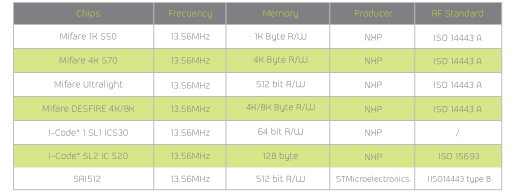RFID Proximity cards
Proximity card contains an IC (chip connected with antenna) laminated with PVC that can be printed in offset o silk-screening and finished with an overlay which protects the printing and allows customization in thermal transfer. Card´s IC are usually passive, i.e. they don´t have an own power supply and they depend on receiving power of the proximity reader. When they receive this small amount of energy from the proximity reader a tag send a response through the antenna. Normal reading distance is 5 cm to 10 cm.
Type of chip
Chips can be read-write or read-only.
Read-only:
Chip contains only a unique permanent identification (UID). Example: this number is used to associate the employees when use the access/attendance control software.
Read/write:
Chip not only contains a UID but also has a memory where information can be recorded. The memory can be from 8 bytes till 8192 bytes. (Note: every letter, number and punctuation mark is equivalent to 1 byte).
Low frequency

High frequency

Ultra High Frequency (UHF)
Our antenna for UHF cards design is optimal for tracking on medium and long-distance applications, and specially suits for emissions by radiofrequency in conflicting environments. This design permits the perfect functioning both in short and large distances. We use the Impinj Monza 4 chip. Monza 4 family offers a variety of models for different applications, introducing new standards in the privacy of RFID, improving the instability of chip position and offering better performance for read/write, as well as the bigger memory capacity.
Communication protocol and memory specifications
Communication protocol EPC Gen 2, ISO 18000-6C, ISO/IEC 15963 (UID standard). Protocol Class 1. The component used: Impinj Monza 4.

